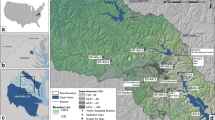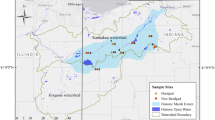Abstract
In steep dry-tropical islands, rural and urban development can lead to accelerated soil erosion and the delivery of land-based materials into marine ecosystems. The objective of this paper was to compare stream water composition, clay minerology, and sediment yield between a partially urbanized (Coral Bay) and an undisturbed (Lameshur) coastal watersheds in St. John, US Virgin Islands (USVI). The saturation index of streamflow water samples was calculated using “The Geochemist’s Workbench” software and most likely precipitated minerals from observed storm events was then compared with X-ray diffraction on soil clay mineralogy. The spatial distribution on both annual mean (2010) erosion rates and storm event–wise (Hurricane Otto) sediment yield among the two study watersheds were modeled using the revised and modified universal soil loss equations (RUSLE; MUSLE), respectively. Cations concentration in stream flow water samples and sediment yield were higher for the partially urbanized (Coral Bay) compared to the undisturbed (Lameshur) watershed. Our findings suggest that rural/urban development may increase stream water cations concentration and inputs of sediment to downstream ecosystems. Future studies evaluating the effect of management practices such as pavement or other stabilization of dirt roads and their impact on stream water quality and quantity and sediment yield are crucial for the proper sediment management in the study watersheds and potentially in other rural-urbanizing tropical watersheds.







Similar content being viewed by others
References
Anderson, D. M., & MacDonald, L. H. (1998). Modeling road surface sediment production using a vector geographic information system. Earth Surface Processes and Landforms, 23, 95–107. https://doi.org/10.1002/(SICI)1096-9837(199802)23:2<95::AID-ESP849>3.0.CO;2-1.
Bethke, C. M. (1996). Geochemical Reaction Modeling. USA: Oxford university press.
Brevik, E. C., Cerdá, A., Mataix-Solera, J., Pereg, L., Quinton, J. N., Six, J., & Van Oost, K. (2015). The interdisciplinary nature of SOIL. SOIL, 1, 117–129. https://doi.org/10.5194/soil-1-117-2015.
Brooks, G. R., Devine, B., Larson, R. A., & Rood, B. P. (2007). Sedimentary development of Coral Bay, St. John, USVI: a shift from natural to anthropogenic influences. Caribbean Journal of Science, 43, 226–243. https://doi.org/10.18475/cjos.v43i2.a8.
Chadwick, O. A., & Chorover, J. (2001). The chemistry of pedogenic tresholds. Geoderma, 100, 321–353. https://doi.org/10.1016/S0016-7061(01)00027-1.
Chen, T., Niu, R., Wang, Y., Li, P., Zhang, L., & Du, B. (2011). Assessment of spatial distribution of soil loss over the upper basin of Miyun reservoir in China based on RS and GIS techniques. Environmental Monitoring and Assessment, 179, 605–617. https://doi.org/10.1007/s10661-010-1766-z.
Dunne, T., & Leopold, L. B. (1987). Water in Environmental Planning (p. 818). New York: W.H. Freeman and Company ISBN 0-71670079-4.
Erns, W. G. (2000). Earth Systems: Processes and Issues. UK: Cambridge University Press.
Fabricius, K. (2005). Effects of terrestrial runoff on the ecology of corals and coral reefs: review and synthesis. Marine Pollution Bulletin, 50, 125–146. https://doi.org/10.1016/j.marpolbul.2004.11.028.
Garcia-Ruiz, J. M. (2010). The effects of land uses on soil erosion in Spain: a review. Catena, 81, 1–11. https://doi.org/10.1016/j.catena.2010.01.001.
Gardner, T. A., Cote, I. M., Gill, J. A., Grant, A., & Watkinson, A. R. (2003). Long-term region-wide declines in Caribbean Corals. Science, 301(5635), 958–960. https://doi.org/10.1126/science.1086050.
Gray, S.C., Gobbi, K.L., & Narwold, P.V. (2008). Comparison of Sedimentation in Bays and Reefs below Developed versus Undeveloped Watersheds on St. John, US Virgin Islands. 11th International Coral Reef Symposium, Ft. Lauderdale, Florida, 7-11 July 2008 Session number 20.
Gray SC, Sears WT, Kolupski DeGrood AM, & Fox MD (2012) Factors affecting land-based sedimentation in coastal bays, US Virgin Islands. Proceedings of the 12th International Coral Reef Symposium, Cairns, Australia July 9th-13th, 2012.
Gudiño Elizondo, N. (2012). Erosión e intemperismo en las cuencas Coral Bay y Lameshur, Isla Saint John de Islas Vírgenes, EUA. Master Degree Thesis, Centro de Investigación Científica y de Educación Superior de Ensenada, México.
Gudino-Elizondo, N., Biggs, T., Bingner, R. L., Yuan, Y., Langendoen, E., Taniguchi, K., Kretzschmar, T., Taguas, E. V., & Liden, D. (2018a). Modelling ephemeral gully erosion from unpaved urban roads: Equifinality and implications for scenario analysis. Geosciences, 8, 137. https://doi.org/10.3390/geosciences8040137.
Gudino-Elizondo, N., Biggs, T., Castillo, C., Bingner, R. L., Langendoen, E., Taniguchi, K., Kretzschmar, T., Yuan, Y., & Liden, D. (2018b). Measuring ephemeral gully erosion rates and topographical thresholds in an urban watershed using unmanned aerial systems and structure from motion photogrammetric techniques. Land Degradation & Development, 29, 1896–1905. https://doi.org/10.1002/ldr.2976.
Gudino-Elizondo, N., Biggs, T., Bingner, R. L., Langendoen, E., Kretzschmar, T., Taguas, E. V., Taniguchi, K., Liden, D., & Yuan, Y. (2019). Modelling runoff and sediment loads in a developing coastal watershed of the US-Mexico Border. Water, 2019(11), 1024. https://doi.org/10.3390/w11051024.
Harden, C. P. (2001). Soil erosion and sustainable mountain development. Mountain Research and Development, 21(1), 77–83. https://doi.org/10.1659/0276-4741(2001)021[0077:SEASMD]2.0.CO;2.
Henry, A., Mabit, L., Jaramillo, R. E., Cartagena, Y., & Lynch, J. P. (2013). Land use effects on erosion and carbon storage of the Rio Chimbo watershed, Ecuador. Plant Soil, 367, 477–491.
Holland, H. D. (1978). The Chemistry of the Atmosphere and Oceans. New York: Wiley.
Hontoria, C., Rodriguez-Murillo, J. C., & Saa, A. (1999). Relationships between soil organic carbon and site characteristics in Peninsular Spain. Soil Science Society of America Journal., 63, 614–621. https://doi.org/10.2136/sssaj1999.03615995006300030026x.
Hubbard, D.K., Stump, J.D., & Carter, B. (1987). Sedimentation and reef development is Hawksnest, Fish and Reef Bays, St. John, U.S. Virgin Islands. Virgin Islands Resource Management Cooperative. Biosphere Reserve Research Report No 21.
Jenny, H. (1961). Derivation of state factor equations of soils and ecosystems. Soil Science Society of America Journal, 25, 385–388. https://doi.org/10.2136/sssaj1961.03615995002500050023x.
Keesstra, S. D., Geissen, V., Van Schaik, L., Mosse, K., & Piiranen, S. (2012). Soil as a filter for groundwater quality. Current Opinions in Environmental Sustainability, 4, 507–516. https://doi.org/10.1016/j.cosust.2012.10.007.
Kinnell, P. (2005). Why the universal soil loss equation and the revised version of it do not predict event erosion well. Hydrological Process, 19, 851–854. https://doi.org/10.1002/hyp.5816.
Kolupski, M. (2011). Sedimentation in coastal bays with coral reefs: impacts of watershed development, Saint John, USVI. Master Degree Thesis, University of San Diego, USA.
LAStools - Efficient tools for LiDAR processing. Version 111216, Martin Isenburg 2011. http://rapidlasso.com/LAStools [accessed on June 2016].
MacDonald, L. H., Anderson, D. M., & Dietrich, W. E. (1997). Paradise threatened: land use and erosion on St. John, US Virgin Islands. Environmental Management, 21(6), 851–863.
MacDonald, L. H., Sampson, R. W., & Anderson, D. M. (2001). Runoff and road erosion at the plot and road segment scales, St. John, US Virgin Islands. Earth Surface Processes and Landforms., 26, 251–272. https://doi.org/10.1002/1096-9837(200103)26:3<251::AID-ESP173>3.0.CO;2-X.
Martinez-Mena, M., Lopez, J., Almagro, M., Boix-Fayos, C., & Albaladejo, J. (2008). Effect of water erosion and cultivation on the soil carbon stock in a semiarid area of South-East Spain. Soil and Tillage Research, 99, 119–129. https://doi.org/10.1016/j.still.2008.01.009.
McCreery, H.F. (2007). “The effect of Anthropogenic Development on Sediment Loading to Bays on St. John, U.S. Virgin Islands, Master Degree Thesis. Massachusetts Institute of Technology, USA.
McHugh, M. (2007). Short-term changes in upland soil erosion in England and Wales: 1999 to 2002. Geomorphology, 86(1-2), 204–213. https://doi.org/10.1016/j.geomorph.2006.06.010.
Millward, A. A., & Mersey, J. E. (1999). Adapting the RUSLE to model soil erosion potential in a mountainous tropical watershed. Catena, 38(2), 109–129. https://doi.org/10.1016/S0341-8162(99)00067-3.
Moore, D. M., & Reynolds, R. C., Jr. (1996). X-ray diffraction and the identification of clay minerals. New York: Oxford University of Press.
National Center for Environmental Information. NOAA, 2011. http://data.nodc.noaa.gov/coris/data/NOAA/nos/Summit2Sea/USVirginIslands/. Accessed 15 July 2011.
Oliver, L. M., Fisher, W. S., Fore, L., Smith, A., & Bradley, P. (2018). Assessing land use, sedimentation, and water quality stressors as predictors of coral reef condition in St. Thomas, U.S. Virgin Islands. Environmental Monitoring and Assessment, 190, 213. https://doi.org/10.1007/s10661-018-6562-1.
Pait, A. S., Galdo, F. R., Jr., Hartwell, S. I., Apeti, D. A., & Mason, A. L. (2018). An assessment of nutrients and sedimentation in the St. Thomas East End Reserves, US Virgin Islands. Environmental Monitoring and Assessment, 190, 270. https://doi.org/10.1007/s10661-018-6628-0.
Radke, J. D. (1997). Detecting potential erosion threats to the coastal zone: St. John, USVI. International Journal of Marine Geodesy, 20, 235–254. https://doi.org/10.1080/01490419709388107.
Ramos-Scharron, C. E. (2012). Effectiveness of drainage improvements in reducing sediment production rates from an unpaved road. Journal of Soil and Water Conservation, 67(2), 87–100. https://doi.org/10.2489/jswc.67.2.87.
Ramos-Scharron, C. E. (2018). Land disturbance effects of roads in runoff and sediment production on dry-tropical, settings. Geoderma, 310, 107–119. https://doi.org/10.1016/j.geoderma.2017.08.035.
Ramos-Scharron, C. E., & LaFevor, M. C. (2016). The role of unpaved roads as active source areas of precipitation excess in small watersheds drained by ephemeral streams in the Northeastern Caribbean. Journal of Hydrology, 533, 168–179. https://doi.org/10.1016/j.jhydrol.2015.11.051.
Ramos-Scharron, C. E., & MacDonald, L. H. (2005). Measurement and prediction of sediment production from unpaved roads, St John, US Virgin Islands. Earth Surface Process and Landforms, 30, 1283–1304. https://doi.org/10.1002/esp.1201.
Ramos-Scharron, C. E., & MacDonald, L. H. (2007a). Runoff and suspended sediment yields from an unpaved road segment. Hydrological Processes, 21, 35–50. https://doi.org/10.1002/hyp.6175.
Ramos-Scharron, C. E., & MacDonald, L. H. (2007b). Development and application of a GIS-based sediment budget model. Journal of Environmental Management, 84, 157–172. https://doi.org/10.1016/j.jenvman.2006.05.019.
Rankin, D.W. (2002). Geology of St. John, U.S. Virgin Islands. U.S. Geological Survey Professional Paper 1631. U.S. Department of Interior, U.S. Geological Survey.
Rawlins, B. G., Ferguson, A. J., Chilton, P. J., Arthurton, R. S., & Rees, J. G. (1998). Review of agricultural pollution in the caribbean with particular emphasis on small island developing states. Marine Pollution Bulletin., 36, 658–668. https://doi.org/10.1016/S0025-326X(98)00054-X.
Renard, K. G., Foster, G. R., Weesies, G. A., McCool, D. K., & Yoder, D. C. (1996). Predicting soil erosion by water: a guide to conservation planning with the Revised Universal Soil Loss Equation (RUSLE). USDA Handbook Number 703. Washington, D.C., USA: USDA.
Rogers, C. (1990). Responses of coral reefs and reef organisms to sedimentation. MARINE ECOLOGY PROGRESS SERIES. Vol., 62, 185–202.
Rogers, C.S., & Teytaud, R. (1988). Marine and terrestrial ecosystems of the Virgin Island National Park and biosphere reserve. U.S. Department of Interior. Biosphere reserve report No. 29.
Snider, D. (1972). National engineering handbook; section 4: Hydrology; chapter 16: Hydrographs Natural Resources Conservation Service.
Trimble, S. W., & Crosson, P. (2000). U.S. soil erosion rates: myth and reality. Science, 289(5477), 248–250. https://doi.org/10.1126/science.289.5477.248.
U.S. Department of Agriculture (1986). Natural Resources Conservation Service. Urban Hydrology for Small Watersheds, TR55. https://www.nrcs.usda.gov/Internet/FSE_DOCUMENTS/stelprdb1044171.pdf. Accessed 15 March 2017.
Wemple, B. C., Browning, T., Ziegler, A. D., Celi, J., Chun, K. P., Jaramillo, F., Leite, N., Ramchunder, S. J., Negishi, J. N., Palomeque, X., & Sawyer, D. (2017). Ecohydrological disturbances associated with roads: Current knowledge, research needs, and management concerns with reference to the Tropics. Ecohydrology, 11, 1–23. https://doi.org/10.1002/eco.1881.
Williams, J. R., & Berndt, H. D. (1972). Sediment yield computed with universal equation. Journal of Hydraulic Division, ASCE, 98(12), 2087–2098.
Wischmeier, W. H. (1976). Use and misuse of the universal soil loss equation. Soil and Water Conservation, 31(1), 5.
Wischmeier, W.H., Smith, D.D. (1978). Predicting rainfall erosion losses – a guide to conservation planning. U.S. Department of Agriculture handbook No. 537.
Woodbury, R. O., & Weaver, P. L. (1987). The vegetation of St. John and Hassel Island, USVI National Park Service, Southeast Region, Research/Resources Management Report SER-83. Atlanta: Georgia.
Acknowledgments
Special thanks to Stephen V. Smith, Alejandro Hinojosa Corona, María Elena Solana Arellano, María Isabel Pérez Montfort, Matthew Brand, Jochen Schubert, Brett Sanders, Robert Harrington, Whitney Sears, Esther Araiza, Mario Vega, Eloisa Aparício, Ivonne Pedrin, Belinda Sandoval, and the Virgin Island Environmental Resource Station (VIERS).
Funding
This study was funded by Consejo Nacional de Ciencia y Tecnología (CONACyT), and the National Oceanic and Atmospheric Administration Ecological Effects of Sea Level Rise Program (award NA16NOS4780206). Field and some lab work were supported by funding from the American Recovery and Reinvestment Act (ARRA) and the National Oceanic and Atmospheric Administration Coral Reef Conservation Program to Dr. Sarah C. Gray from University of San Diego.
Author information
Authors and Affiliations
Corresponding author
Additional information
Publisher’s note
Springer Nature remains neutral with regard to jurisdictional claims in published maps and institutional affiliations.
Rights and permissions
About this article
Cite this article
Gudino-Elizondo, N., Kretzschmar, T. & Gray, S.C. Stream flow composition and sediment yield comparison between partially urbanized and undisturbed coastal watersheds—case study: St. John, US Virgin Islands. Environ Monit Assess 191, 676 (2019). https://doi.org/10.1007/s10661-019-7778-4
Received:
Accepted:
Published:
DOI: https://doi.org/10.1007/s10661-019-7778-4




